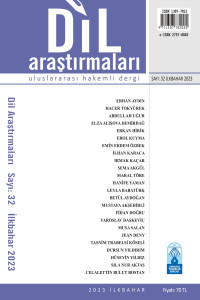Öz
Türklerde at ile ilgili ilk Türkçe kaynaklar, doğal olarak Türk runik harfli eski Türk yazıtlarıdır. Bu yazıtlarda at sözcüğü ve buna bağlı birçok türev tespit edilmiş olsa da esasen atları konu edinen metin, kuşkusuz Köl Tegin Yazıtı’dır. Ağabeyi Bilge Kağan tarafından metni oluşturulup diktirildiği bilinen Köl Tegin Yazıtı’nın doğu yüzünün 40. satırı ile kuzey yüzünün 2, 2 ve 3. satırında tespit edilen ve şalcı, şalci, şalçı, şalçi gibi türlü biçimlerde okunan bu ad, kimilerince atın sahibi, kimilerince ise atın adı olarak değerlendirilmiştir.
Bu makalenin ilk bölümlerinde dört kez geçen sözcüğün, yazıt üzerinde çalışanlarca nasıl okunup anlamlandırıldığına yer verilmiş; ardından sözcüğün orta Moğolcanın önemli kaynakları Moğolların Gizli Tarihi ve Defter-i Çingiz-nâme’de de geçtiği biçimle karşılaştırılarak Türkçe sal ‘sal’ ve isimden isim yapan +çI eki ile kurulmuş ve ‘salcı’ anlamında olabileceği önerilmiştir. Sözcüğün Moğolca ve Türkçe metinlerinde geçen biçimleri üzerinde de durulmuştur. Makalenin değerlendirme bölümünde ise Türkçe salçı sözcüğünün Moğolistan’ın batı taraflarında, Kırgızistan’da bir yer olabileceği ve dolayısıyla da, Köl Tegin yazıtı temelinde, bozkırda yaşayan Türklerin, uzak diyarlara sefer yaparken o bölgenin atlarına bindiği ve saldırdığı görüşüne yer verilmiştir. En azından kuzey ve batı seferlerinde binilen atlar verilmek suretiyle, binlerce kilometrelik bölgelere sefere çıkılırken Moğolistan’daki kısa boylu atlarına değil, sefer edilen bölgenin atlarına binilmiş olabileceği ve dolayısıyla da Türkçe salçı sözcüğünün bir yer adı olabileceği öne sürülmüştür.
Anahtar Kelimeler
Eski Türkçe eski Türk yazıtları Köl Tegin yazıtı atlar sal salçı Old Turkic The old Turkic inscriptions Köl Tegin inscription horses raft raft maker or raftman.
Kaynakça
- SINOR, D. (2003). “İç Asya Kavramı”. Türkçeye çev: R. SEZER, Erken İç Asya Tarihi (Der. D. SINOR) İstanbul: İletişim, 11-32.
- STREET, J. C. (1990). “Nominal Plural Formations in the Secret History”. Acta Orientalia Academiae Scientiarum Hungaricae, 44/3: 345-379.
- ŞİRİN, H. (2016). Eski Türk Yazıtları Söz Varlığı İncelemesi. Ankara: Türk Dil Kurumu.
- TAŞAĞIL, A. (2004). Çin Kaynaklarına Göre Eski Türk Boyları. Ankara: Türk Tarih Kurumu.
- TEKİN, T. (1988). Orhon Yazıtları. Ankara: Türk Dil Kurumu.
- TEKİN, T. (2003). Orhon Türkçesi Grameri. İstanbul: Türk Dilleri Araştırmaları Dizisi.
- TEMİR, A. (1995). Moğolların Gizli Tarihi. Ankara: Türk Tarih Kurumu.
- THOMSEN, V. (2002). Orhon Yazıtları Araştırmaları. Çev.: V. KÖKEN, Ankara: Türk Dil Kurumu.
- THOMSEN, V. (1935). Moğolistan’daki Türkçe Kitabeler, Çev.: R. H. ÖZDEM, Türkiyat Mecmuası, 3: 81-119.
Öz
The first Turkic sources on horse subject in Turks are naturally the old Turkic inscriptions with Turkic runic letters. Although the word horse and many derivatives have been identified in these inscriptions, the text that mainly deals with horses is undoubtedly the Köl Tegin inscription. This name, which is identified in the 40th line of the eastern face and the 2nd, 2nd and 3rd line of the north face of the Köl Tegin inscription, whose text we know was created and erected by his brother Bilge Kağan, and read in various forms such as šalcı, šalci, šalčı, šalči, by some, the owner of the horse, some of them the horse. It was evaluated as the name.
In the first parts of this article, it is mentioned how the word, which is mentioned four times, is read and interpreted by those who work on the inscription, and then it is compared with the form in which the word is mentioned in the important sources of Middle Mongolian, The Secret History of the Mongols and the Defter-i Čingiz-nama. Turkic sal was established with ‘raft’ and the suffix + çI, which makes a name from the noun, and it has been suggested that it can mean ‘raft maker or raftman’. The forms of the word in Mongolian and Turkish texts are also emphasized. In the evaluation part of the article, it is stated that the Turkish word salčı can be a place in the western parts of Mongolia, Kyrgyzstan, and therefore, on the basis of the Köl Tegin inscription, the Turks living in the steppe ride and attack the horses of that region while traveling to distant lands. It has been suggested that the horses of the region, not the short-stature horses in Mongolia, may have been ridden, and therefore the Turkish word salçı may have been a place name when sailing to the regions of thousands of kilometers, at least by giving horses on the north and west cruises.
Anahtar Kelimeler
Old Turkic The old Turkic inscriptions Köl Tegin inscription horses raft raft maker or raftman.
Kaynakça
- SINOR, D. (2003). “İç Asya Kavramı”. Türkçeye çev: R. SEZER, Erken İç Asya Tarihi (Der. D. SINOR) İstanbul: İletişim, 11-32.
- STREET, J. C. (1990). “Nominal Plural Formations in the Secret History”. Acta Orientalia Academiae Scientiarum Hungaricae, 44/3: 345-379.
- ŞİRİN, H. (2016). Eski Türk Yazıtları Söz Varlığı İncelemesi. Ankara: Türk Dil Kurumu.
- TAŞAĞIL, A. (2004). Çin Kaynaklarına Göre Eski Türk Boyları. Ankara: Türk Tarih Kurumu.
- TEKİN, T. (1988). Orhon Yazıtları. Ankara: Türk Dil Kurumu.
- TEKİN, T. (2003). Orhon Türkçesi Grameri. İstanbul: Türk Dilleri Araştırmaları Dizisi.
- TEMİR, A. (1995). Moğolların Gizli Tarihi. Ankara: Türk Tarih Kurumu.
- THOMSEN, V. (2002). Orhon Yazıtları Araştırmaları. Çev.: V. KÖKEN, Ankara: Türk Dil Kurumu.
- THOMSEN, V. (1935). Moğolistan’daki Türkçe Kitabeler, Çev.: R. H. ÖZDEM, Türkiyat Mecmuası, 3: 81-119.
Ayrıntılar
| Birincil Dil | Türkçe |
|---|---|
| Konular | Dil Çalışmaları |
| Bölüm | Makaleler |
| Yazarlar | |
| Yayımlanma Tarihi | 30 Mayıs 2023 |
| Yayımlandığı Sayı | Yıl 2023 Cilt: 17 Sayı: 32 |


